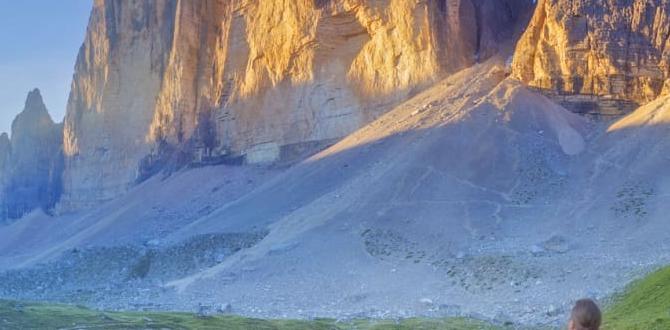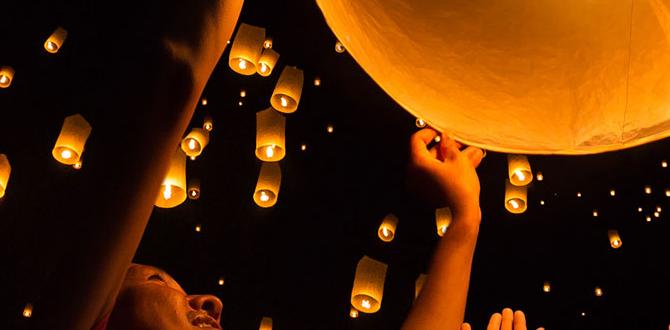Planning a Bavaria shoulder season trip offers fewer crowds, pleasant weather, and often lower prices, making it an ideal time to experience its charming towns, stunning castles, and beautiful landscapes without the summer rush.
Bavaria in the shoulder seasons – spring and fall – is a pure delight. Forget the bustling crowds of peak summer! You can explore magnificent castles and wander through storybook villages at a more relaxed pace. This guide is designed to help you plan a seamless, enjoyable trip, ensuring comfort and unforgettable memories every step of the way. We’ll cover the best times to visit, what to pack, and how to make the most of Bavaria’s charm when the seasons are just right. Let’s plan your perfect Bavarian adventure!
Why Visit Bavaria in the Shoulder Season?
Choosing the shoulder season for your Bavarian getaway is a smart move for a multitude of reasons. It’s that sweet spot where you get the best of many worlds – think comfortable weather, fewer tourists, and usually, a friendlier price tag on flights and accommodation. If you’re looking for a travel experience that’s both rich in culture and conveniently stress-free, this is it.
Fewer Crowds, More Charm: Imagine strolling through the charming streets of Rothenburg ob der Tauber or exploring Neuschwanstein Castle without feeling rushed or like you’re in a constant queue. Shoulder seasons mean you can truly soak in the atmosphere.
Pleasant Weather: While not as consistently warm as summer, spring (April-May) and fall (September-October) offer mild temperatures ideal for sightseeing and outdoor activities. You’ll experience vibrant spring blooms or breathtaking autumn foliage.
Budget-Friendly Travel: Airlines and hotels often offer more competitive rates during these transitional periods. This means your travel budget can stretch further, allowing for more experiences or upgraded stays.
Authentic Experiences: With fewer tourists, you’re more likely to encounter local life and enjoy a more authentic feel to the towns and villages you visit. Restaurants might offer seasonal specials, and local festivals can still dot the calendar.
Understanding Bavaria’s Shoulder Seasons
Bavaria, in the heart of Germany, experiences distinct spring and autumn periods that are perfect for mindful travelers. Knowing when these seasons officially fall and what to expect in terms of weather and events can significantly enhance your planning.
Spring in Bavaria (April – May)
Spring is a time of reawakening in Bavaria. The snow melts, wildflowers begin to dot the Alpine meadows, and beer gardens start to buzz again.
April: Still can be a bit chilly, with a chance of lingering snow in higher altitudes. Cherry blossoms and early spring flowers might be visible. Average temperatures range from 4°C (39°F) to 14°C (57°F).
May: Warmer and more vibrant. Expect blooming trees, lush green landscapes, and pleasant weather for exploring. Temperatures typically hover between 8°C (46°F) and 19°C (66°F). May is a popular month for hiking and outdoor festivals.
Autumn in Bavaria (September – October)
Autumn transforms Bavaria into a canvas of reds, oranges, and yellows. The air is crisp, and the harvest season brings its own set of delights.
September: Often considered one of the best months. The weather is usually stable, sunny, and pleasantly warm, with highs around 19°C (66°F) and lows of 9°C (48°F). The Oktoberfest traditionally begins this month.
October: Cooler, with a higher chance of rain but also stunning fall colors. Temperatures drop to an average of 5°C (41°F) to 14°C (57°F). The latter half of October can feel quite autumnal.
Essential Packing Guide for Bavaria’s Shoulder Season
Packing smart is key to enjoying Bavaria’s shoulder season. The weather can be unpredictable, so layering is your best friend.
Clothing Essentials
Layers, Layers, Layers! This is non-negotiable. Pack t-shirts, long-sleeved shirts, and a fleece jacket or sweater.
Base Layers: Moisture-wicking tops and thermal leggings (especially for early spring or late fall).
Mid-Layers: Sweaters, fleeces, or cardigans for warmth.
Outer Layer: A waterproof and windproof jacket is essential. Look for something breathable.
Comfortable Walking Shoes: You’ll be doing a lot of exploring on foot, so sturdy, broken-in walking shoes or hiking boots are a must. Consider waterproof options.
Jeans or Comfortable Trousers: A couple of pairs will work well for general sightseeing.
Scarf, Hat, and Gloves: Evenings can get cool, and a hat and gloves can make a big difference on a breezy day.
Socks: Pack plenty of comfortable socks, ideally wool or synthetic blends for warmth and moisture-wicking.
One Nicer Outfit: For a special dinner or an evening at a traditional Bavarian restaurant.
Rain Protection: A compact umbrella or a waterproof jacket with a hood.
For Peace of Mind and Comfort: Travel Basics & Personal Needs
As Michael C. Herrera of Journey Essentials, I always emphasize comfort and readiness. For any trip, having your personal care needs met can drastically reduce travel stress.
Backpack or Daypack: For carrying essentials like water, snacks, a guidebook, an umbrella, and perhaps an extra layer during the day.
Reusable Water Bottle: Stay hydrated and reduce plastic waste.
Portable Power Bank: For charging your phone or camera on the go.
Travel Adapter: Germany uses Type F sockets.
Comfort Aids: Depending on your personal needs, consider comfortable, highly absorbent adult diapers or child diapers if traveling with little ones. Wearing appropriate products can allow for longer excursions and reduce anxiety about bathroom access abroad. Brands offering discreet and comfortable options are a lifesaver for extended journeys, whether by air, train, or car. Knowing you have reliable protection means you can focus on the beauty around you, not worry about potential leaks or discomfort.
Small First-Aid Kit: Include plasters, antiseptic wipes, pain relievers, and any personal medications.
Planning Your Bavarian Itinerary: Key Destinations
Bavaria is rich with diverse attractions, from fairytale castles to vibrant cities and serene lakes. The shoulder season is perfect for exploring these gems without the peak summer crowds.
Popular Destinations & Shoulder Season Appeal
| Destination | Spring Appeal (April-May) | Autumn Appeal (September-October) | Shoulder Season Advantage |
| :—————– | :————————————————————– | :—————————————————————- | :———————————————————————————————————————– |
| Munich | Lively beer gardens opening, parks blooming, pleasant city walks. | Oktoberfest (early Sept), crisp air, beautiful autumn foliage in parks. | Easier access to museums and attractions; more relaxed vibe in public spaces. |
| Neuschwanstein Castle | Fewer visitors, stunning green landscapes surrounding the castle. | Vibrant fall colors, dramatic sky backdrops, fewer tour groups. | Shorter wait times for tickets and tours, better photo opportunities without throngs of people. |
| Rothenburg ob der Tauber | Flowers blooming, charming medieval streets to yourself. | Golden foliage, festive atmosphere (especially if near Christmas markets prep). | Peaceful strolls along the ramparts, enjoying the quintessential medieval town experience. |
| Bavarian Alps | Hiking trails opening, wildflowers, snow-capped peaks. | Stunning autumn colors, crisp hiking weather, fewer crowds on trails. | More serene hiking and lake visits (e.g., Königssee, Eibsee) without the summer rush. |
| Nuremberg | Historic sites accessible, pleasant weather for city exploration. | Autumnal charm, transition towards Christmas market preparations (late Oct). | More intimate experience at historical sites like the Imperial Castle and Documentation Center. |
Sample Itinerary Ideas
Here are a couple of ideas to get you started. Remember, these are flexible!
Idea 1: Romantic Road & Castles (7 Days)
Day 1-2: Munich: Arrive, explore Marienplatz, English Garden. Consider a day trip to Dachau Concentration Camp Memorial Site for historical context.
Day 3: Füssen/Neuschwanstein: Travel to Füssen, visit Neuschwanstein and Hohenschwangau Castles.
Day 4: Rothenburg ob der Tauber: Drive or take a train to this picturesque medieval town. Walk the town walls.
Day 5: Dinkelsbühl & Nördlingen: Explore these charming towns along the Romantic Road.
Day 6: Nuremberg: Visit the Imperial Castle, explore the Old Town, and the Documentation Center.
Day 7: Departure: Depart from Munich or Nuremberg.
Idea 2: Bavarian Alps & Lakes (5 Days)
Day 1: Munich: Arrive, settle in, maybe a quick visit to Hofbräuhaus.
Day 2: Garmisch-Partenkirchen & Zugspitze: Train to Garmisch. Ascend Germany’s highest peak for breathtaking views.
Day 3: Füssen/Castles: Travel to Füssen, visit Neuschwanstein and Hohenschwangau.
Day 4: Königssee & Berchtesgaden: Explore the stunning emerald-green lake and the historic salt mines or Eagle’s Nest (weather permitting).
Day 5: Departure: Travel back to Munich for departure.
Transportation in Bavaria
Getting around Bavaria is generally straightforward and pleasant, especially during the shoulder season when public transport is less packed.
Getting To and Around Bavaria
By Air:
Munich Airport (MUC): Bavaria’s main international gateway. Easily connected to the city center via S-Bahn (suburban train).
Nuremberg Airport (NUE): A smaller airport with connections to major European cities. Connected to the city by subway.
By Train: Germany’s Deutsche Bahn (DB) train network is extensive, efficient, and reliable.
Booking: Book tickets in advance, especially for long distances, using the official Deutsche Bahn website for the best prices. Consider regional ‘Länder-Tickets’ for day trips within Bavaria, which offer unlimited travel for a group within a specific region.
Shoulder Season Advantage: Trains are less crowded, making journeys more comfortable and scenic viewing easier.
By Car:
Rental: Renting a car offers the most flexibility, especially for exploring the Romantic Road or the Alps. You can pick up cars at airports or major train stations.
Driving: Roads are well-maintained. Be aware of German driving laws, speed limits, and that some areas have environmental zones requiring a sticker. The Autobahn has sections without a speed limit, but many have them. Always check signage.
Public Transport within Cities:
Munich: Excellent network of U-Bahn (subway), S-Bahn, trams, and buses. Day tickets or weekly passes are cost-effective.
Other Cities: Most towns and cities have good local bus and tram systems.
Practical Tips for a Stress-Free Trip
Here are some tips to ensure your Bavarian shoulder season trip is as smooth and enjoyable as possible.
Pre-Trip Preparations
1. Book Accommodation and Key Attractions: While crowds are smaller, popular spots like Neuschwanstein Castle can still book up.
2. Travel Insurance: Always recommended for any international trip.
3. Learn Basic German Phrases: While many Bavarians speak English, knowing simple phrases like “Danke” (Thank you), “Bitte” (Please), and “Entschuldigung” (Excuse me) is appreciated.
4. Currency: Euros (€ EUR). While cards are widely accepted, carry some cash for smaller shops, markets, or rural areas.
5. Check Opening Hours: Especially for attractions outside of major cities, opening hours can vary seasonally. Refer to official websites like Bavarian Palace Department for castle times.
During Your Trip
Embrace the Weather: Pack layers and be prepared for both sunny and rainy days. A good attitude makes all the difference!
Stay Connected: Consider a local SIM card or an international data plan for navigation and communication.
Comfort is Key: Don’t underestimate the importance of comfortable footwear and appropriate clothing. If managing personal care needs, ensure you have a discreet and sufficient supply of adult or child diapers to avoid any worry. This allows you to fully immerse yourself in the experience, from a long scenic hike to an all-day exploration of a castle.
Be Flexible: Shoulder seasons can sometimes have unexpected weather shifts. Have a backup plan for rainy days, like visiting a museum or a cozy café.
Enjoy Local Cuisine: Don’t miss out on Bavarian specialties like Weißwurst, Schweinshaxe, and pretzels, paired with local beer or Apfelschorle.
Frequently Asked Questions (FAQ)
Q1: Is Bavaria safe to travel to in the shoulder season?
A1: Yes, Bavaria is a very safe region to travel in. Like any travel, it’s always wise to be aware of your surroundings and take standard precautions against petty theft, especially in crowded tourist areas.
Q2: What is the best month for Bavaria’s shoulder season?
A2: May and September are often considered the sweet spots. May offers blooming nature and pleasant warmth, while September provides stable, mild weather and the famous Oktoberfest atmosphere if you time it right.
Q3: Do I need to book Neuschwanstein Castle tickets in advance during the shoulder season?
A3: Absolutely. Even in the shoulder season, Neuschwanstein Castle is highly popular. It is strongly recommended to book your tickets online several weeks or even months in advance to secure your preferred date and time.
Q4: Can I hike in the Bavarian Alps during the shoulder season?
A4: Yes, but with caution. Spring hiking trails can still have snow at higher elevations, especially in early April. Autumn offers beautiful hiking, but be prepared for cooler temperatures and potential early snowfalls in late October. Always check local trail conditions and weather forecasts.
Q5: Are beer gardens open in the shoulder season?
A5: Many beer gardens start opening in April as the weather warms up and will remain open through September and sometimes into October, weather permitting. It’s a lovely way to experience Bavarian culture during these seasons.
Q6: What kind of power adapter do I need for Bavaria?
A6: Germany uses Type F electrical sockets, which have two round pins. You will need an adapter for most non-European electronic devices. The standard voltage is 230V.
Q7: How important is it to pack for variable weather?
A7: Extremely important. Bavaria’s weather in spring and fall can change rapidly. Expect cool mornings, warm afternoons, and potential rain. Layers are essential, and a waterproof outer layer is a must.
Conclusion
Planning a trip to Bavaria during the shoulder season is a pathway to an incredibly rewarding travel experience. You’ll find a land of majestic castles, charming villages, and breathtaking natural beauty, all enjoyed with a sense of calm and authenticity that peak season often misses. By understanding the nuances of spring and autumn, packing wisely with layers, and utilizing the efficient transport networks, you’re set for adventure. Whether you’re navigating the historic streets of Munich, gazing up at Neuschwanstein, or hiking through autumnal forests, the ease and charm of a shoulder season visit will leave you with cherished memories and a desire to return. Embrace the pleasant weather, the fewer crowds, and the genuine Bavarian spirit for a journey that’s both comfortable and unforgettable. Happy travels!




